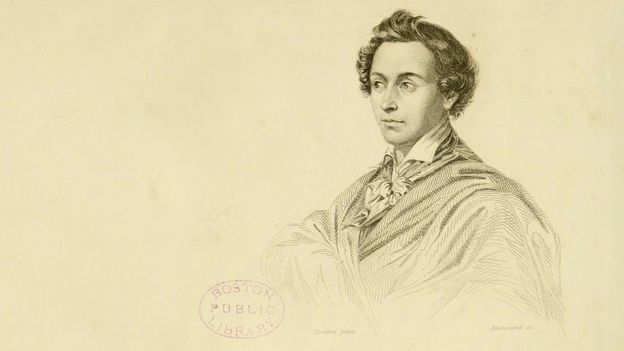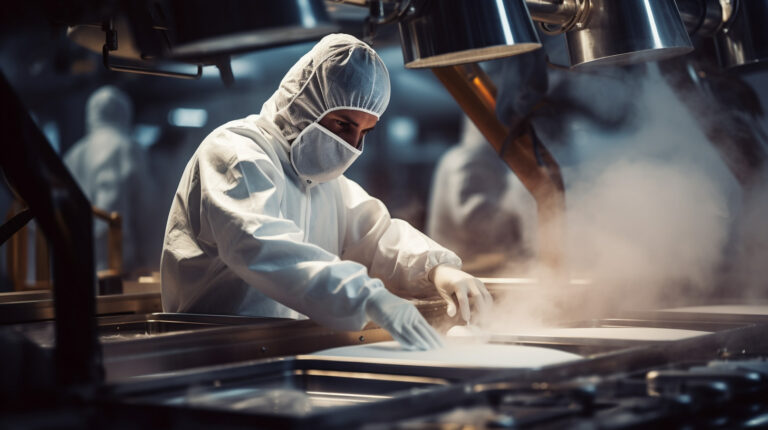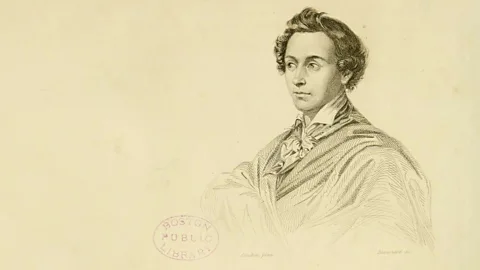 Alamy
AlamyA new Apple TV+ series explores the life of the so-called “King of Chefs and the Chef of Kings” – shown as a wild enfant terrible in post-Revolutionary France who blazed a trail for future generations of cooks.
It’s described as “the story of the first celebrity chef”. The French language series Carême is a dramatisation of the life of Antonin Carême, who was born into poverty in pre-Revolutionary Paris around 1784. His talent would make him chef for the French diplomat Charles Talleyrand, the Emperor Napoleon, the future George IV of Britain, Tsar Alexander of Russia and the Baron de Rothschild. He also wrote celebrated cookbooks and introduced the Torque (the tall chef’s hat), still in use today – giving birth to the very idea of the “celebrity” chef.
Indeed, Benjamin Voisin, the actor playing Antonin Carême, believes that if the chef had been working in the 2020s, “he’d have been the one with 100 million views on TikTok. That would be the equivalent of what he did at the time,” he tells the BBC.
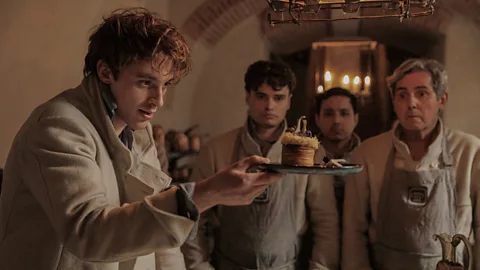 Apple TV+
Apple TV+And Voisin’s portrayal of Carême feels modern; he plays him with a touch of the rock star as well as kitchen chef. He wears an earring, his clothes seem to owe more to the 1980s New Romantic movement than 19th-Century costume, and from his affairs with women to his lack of deference to his so-called superiors, he is what could be described (in French) as an enfant terrible. He is also confident, brash and authoritative in his kitchen – a manner that echoes 21st-Century celebrity chefs such as Gordon Ramsay.
The series is inspired by a biography of Carême and his gastronomy by Ian Kelly, who also co-created the series with screenwriter Davide Serino. The historical figure of the young chef is actually described by Kelly in his book as a “bookish innocent” when he takes his first job, but Voisin’s look in the series isn’t too far from Kelly’s description of Carême aged 25: “He was handsome, his hair cut and tousled forward in the fashionably Byronic manner… he was described as slight, and a slight eater.” Kelly also describes Carême as “ambitious, solipsistic, even narcissistic” as a person – although the Carême on screen risks much for those he loves.
Indeed, perhaps inevitably, the series takes various liberties with the truth, also depicting Carême as a spy for his powerful masters, something there’s no historical evidence for. The show’s lead director Martin Bourboulon describes the added drama as “the charm of fiction in the show”. The reality is that the real man didn’t leave much information behind. As Kelly says in his biography, “He [Carême] would disclose the minutiae of his professional life… and the menus, guests and ingredients that made up his working days. But about his personal life he revealed nothing.”
What is true to the era is the depiction of the aristocratic kitchens he worked in, his small army of staff, and their fevered preparations for royal banquets. He’s seen in the series organising a meal for Napoleon Bonaparte, and in real life he was responsible for the Emperor’s wedding cake. Carême’s ability to sugar-sculpt led to extraordinary creations in the shape of classical lyres and Venetian gondolas, all carefully sketched out on paper first by the chef himself. But that wasn’t all he was capable of, according to Paul Freedman, Professor of History at Yale University.
“He helped establish a routine for how kitchens were run,” Freedman tells the BBC. “He also defined dishes and the repertoire of sauces, what was considered to go with what food, what kind of garnishes would be standard, and the kind of multi-course dining that would come to be characteristic [of haute cuisine]. And as his original metier was confectionary and sugar sculpting, even having a centrepiece of sculpted food is owed to Carême.”
While some of the real-life recipes in his cookbooks still sound mouthwatering (Kelly mentions an orange flower and pink champagne jelly), others, such as a stuffed boar’s head, might seem strange to today. But Bourboulon says that, above all, he wanted to make the chef himself accessible to a modern audience.
Bourboulon, responsible for two successful film adaptations of Alexandre Dumas’s historical novel The Three Musketeers, tells the BBC that he wanted to avoid “the usual period drama style” in this story.
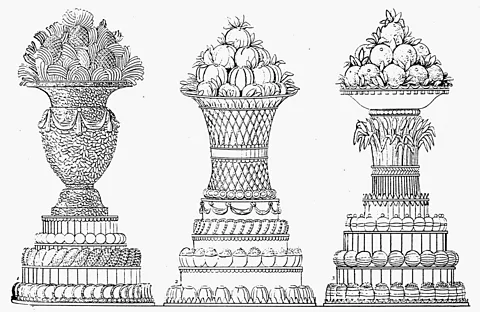 Alamy
Alamy“I really wanted to bring some a bit of sexiness, rock ‘n’ roll attitude, and a modern twist for all the main characters, especially Carême,” he says. “And Benjamin Voisin is like this in real life.”
Voisin says their idea of the chef was that he had “a Mick Jagger aspect to him. It’s really what attracted me”.
“I love looking to the historical story of Carême, but this rock star element, that kind of Lenny Kravitz look he has, plus the idea the show gives about his attitude to life, is really important. Maybe that’s why Martin came to me to talk about playing him. I also love the story of this young man trying to find his place in society.”
The historical Carême’s stellar career might well have given him a swagger; he was known as “the King of Chefs and the Chef of Kings”. He’s often credited as a founder of French gastronomy and of Grande Cuisine (classic French cuisine which was at its most lavish during the 19th Century).
However, according to Paul Freedman, Professor of History at Yale University, he might not even be France’s first celebrity chef. The Frenchman Guillaume Tirel, known as “Taillevent”, is famous for cooking for French kings during his lifetime (1310-95), and wrote a cookbook that still survives, The Viandier. Several restaurants still bear his name.
Carême’s status is, he says, “a celebrity chef of modern Europe, but still almost the last of a kind. He lived still in the time of the courts and chefs finding aristocratic patrons. He doesn’t have a restaurant or interact with ordinary people, [and] his tremendous number of cookbooks aren’t directed towards amateurs, but towards other chefs.
“So he’s a transitional point to the purely modern celebrity chef, who are celebrities in the sense of media exposure, their television presence or just their ability to be a character and to run a restaurant.”
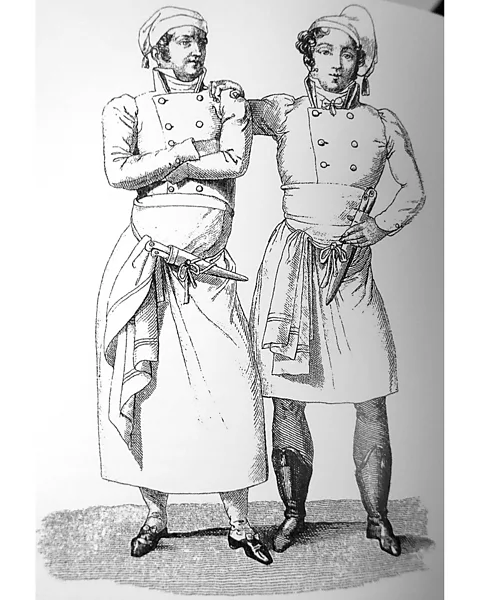 Alamy
AlamyThe young Carême’s turnaround in life was remarkable. Historian Ian Kelly describes him in his biography, Carême: The First Celebrity Chef (which inspired the series) as one of multiple children in a family from one of Paris’s worst slums. By 1792, around the same time that the “Reign of Terror” would begin in the French Revolution (a period of state-sanctioned violence and executions) he had been abandoned by his parents but was taken in by a cook, and then apprenticed to a notable pâtissier, Sylvain Bailly. While still a very young man, he was hired by one of the most famous politicians of the Napoleonic era: Prince Charles Maurice Talleyrand-Périgord, known as Talleyrand.
Even if the real Carême didn’t dabble in espionage, Bourboulon points out that the chef’s culinary brilliance would have been exploited as a display of power by his employers, and that food would have been as much a part of diplomacy during the early 19th Century as the modern state banquet is now.
“We know that Carême worked for Prince of Talleyrand and for Napoleon,” he tells the BBC. “It’s so French to share the menu, the food, and use the quality of the food to help diplomatic relationships, and historically, they really did do this. There’s an example at the end of the first episode, when Carême brings in a dessert for Napoleon and an English diplomat seated at the same table. And it’s exactly how we imagine it would have been done during that time.”
Food and sensuality
Politics isn’t the only display of passion in the narrative either, or as Bourboulon says, “Love is as important in the lives of French people, possibly more so”. The visuals directly link the food Carême cooks with sensuality; the camera lingers over the dishes, while red fruit drips over the title sequence. The series even starts with Carême licking cream off his love interest Henriette, played by Lyna Khoudri.
“The parallel between the two types of pleasure is there in the series,” Voisin says. “Hands are involved in both cooking and the pleasures of the flesh, that’s the connection.”
The link between French food and sensuality are linked was certainly there in Carême’s Paris. Ian Kelly describes how the post-Revolution capital “had become the City of Light – and the capital of food”. The talk around the young Carême, he says, would have been “of philosophy, fashion, food and sex: what the world has come to expect from Paris”.
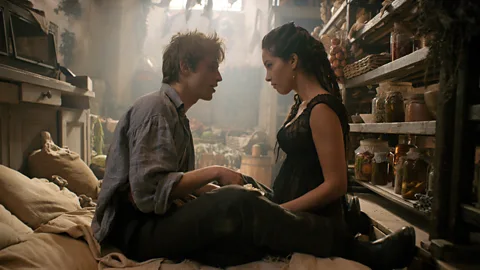 Apple TV+
Apple TV+“I think it goes back to the image that France continues to have today as pleasure loving, as sophisticated, not merely gorging themselves or getting drunk, but [possessed of] a kind of sensuality that is cultivated in the sense it’s tasteful and distinguished,” he tells the BBC.
A French chef, he explains, would become necessary as a status symbol for many aristocrats of the 19th and 20th Century. “One of the biggest examples in literature is PG Wodehouse writing about one of Bertie Wooster’s aunts, Dahlia, living in terror that her temperamental French chef, Anatole, would quit “
The era of the celebrity restaurant chef was ushered in by Carême’s growing fame, and the cookbooks he wrote, according to Professor Nathalie Cooke, the author of Tastes and Traditions: A Journey Through Menu History. Before the French Revolution, restaurants existed in limited form in Paris, but most served only soup. Their proliferation, Cooke tells the BBC, was born from “economic disaster”.
“Imagine you’re an aspiring young chef and you’re working in Paris in the late 18th Century, and they’ve beheaded Marie Antoinette, and they’re getting rid of all those jobs that you’ve aspired to, cooking for royalty and the aristocracy,” she says. “That’s why the restaurant culture grew: these very skilled chefs needed to make money and find an audience during economic turbulence, and in a post-royalty age. That’s also why Carême wrote cookbooks: he was establishing himself in this new age of print media, but also, by addressing his work to other chefs, he was training a new breed of chef that was going to serve a larger audience instead of just royalty.”
A later French celebrity chef who dominated European food culture, Auguste Escoffier, (1846-1935) – who ran restaurants at the Ritz hotels in Europe, and at the Savoy Hotel and Carlton Club in London – “is really Carême’s heir,” Cooke says.
“Escoffier really becomes famous when he decides to write down formal French cooking methods,” she explains. “He was able to achieve Carême’s vision [of making recipes accessible to other chefs] in a way that Carême could not, because Carême was living in the age of the birth of restaurant culture, which was only just developing and only in Paris. Escoffier took it to London too.” (Carême did spend time in England, serving the then Prince Regent, later George IV, but although he cooked for Tsar Alexander of Russia in Paris, he refused to move there and take a job.)
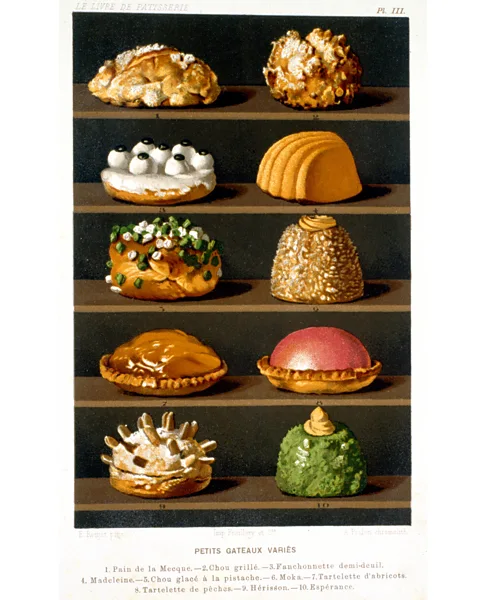 Alamy
AlamyThe emergence of TV and radio (and later internet) in the 20th Century has meant that the celebrity chef has become an international phenomenon, not just confined to those writing cookbooks or running restaurants, but open to all those with a knack for connecting with their audience. The most famous chef of the television era, Julia Child, (portrayed by Meryl Streep in the 2009 film Julie and Julia) was an American who had lived in Paris, and a devotee of French cooking. She even received the Antonin Carême Medal for excellence, although this is a US, not a French, honour.
In another nod to modernity, the young Carême in the series is also shown taking part in a chef’s competition, normalised now by the growth of shows such as Iron Chef, MasterChef, and The Great British Bake Off (which streams internationally as The Great British Baking Show.) While the latter’s “Showstopper” category might trace its ancestry back to Carême’s own sugar sculptures of the 19th Century, the first modern professional event of this kind for chefs started in 1983, when another chef, Paul Bocuse, established the Bocuse D’Or, in Lyon, France.
But now that TV shows, podcasting and social media also allow skilled amateurs to become celebrities, Paul Freedman says there are characteristics of how he discerns a truly “celebrity” chef
“My definition in books and articles that I’ve written is that the contemporary celebrity chef is distinguished by being regarded as a genius or an artist, [as opposed to] people who are [just] excellent at their craft. The Frenchman Paul Bocuse would be the first celebrity chef according to that definition, in the 1980s. Even before he invents dishes, he created the ethos of the chef as genius, and a version of a creative artist. So the celebrity chefs of our era are excellent at their craft, but Ferran Adrià, who was at El Bulli, or René Redzepi of Noma, or Heston Blumenthal in Britain are all [also] creative geniuses, or at least that’s how they’re presented.”
 Getty Images
Getty ImagesThere is though, a direct line traceable from their creations, and their kitchens, to those of Antonin Carême – and not just because some of them might still wear a Torque. Bourboulon hopes that this new portrayal of the chef, nearly 200 years after he died, will give his legacy new attention.
“Although Carême’s name is quite famous in France, it could be even more famous, I think,” he says. “I would love people to rediscover, or just discover, what he did, how this young man brought all his talents to the tables of these powerful men like Napoleon. His life is a really exciting thing to mix together – food, love and politics.”
Carême premieres globally on Apple TV+ from April 30, 2025.
